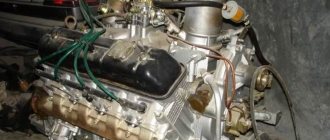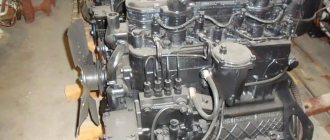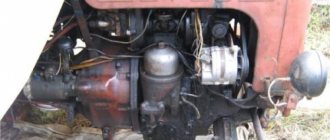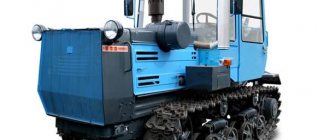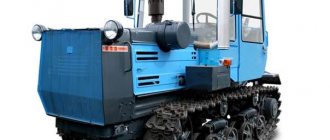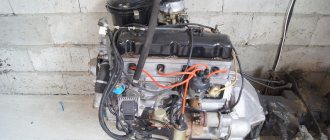GAZ 53 trucks, equipped with GAZ-53 and ZMZ-53 internal combustion engines, became a kind of symbol of the era of the Soviet Union. These cars were produced in the 60s of the last century at the Gorky Automobile Plant. In the first models, produced from 1961 to 1966, the GAZ 53 engine was installed on the cars, after which it was replaced by the ZMZ 53 engine. These Y-shaped eight-cylinder power units are distinguished by high efficiency, have excellent power characteristics, develop sufficient torque for use in extremely difficult conditions.
Technical characteristics of GAZ 53 and ZMZ 53 engines
| Engine capacity GAZ 53 (ZMZ 53) | 4.25 liters |
| Developed power | 115 horsepower |
| Piston diameter | 92 mm |
| Piston pin, length | 25 mm |
| Piston stroke length | 80 mm |
| Compression ratio | 6.7 atmospheres |
| Fuel supply type | forced submission |
| Fuel pump brand | B9D |
| Pump capacity | 140 l/hour |
| Gas tank volume | 90 liters |
| Fuel tank location | under the cabin |
| Carburetor type | two-chamber |
| Air cleaning | two-stage |
| Material of manufacture of the replacement filter element | nylon |
| Weight of GAZ 53 engine without gearbox (ZMZ 53) | 265 kg |
| Oil volume in the GAZ 53 (ZMZ 53) engine | 8 liters |
| Cylinder arrangement | Y-shaped |
| Number of cylinders | 8 pieces |
| Cooling system | liquid |
| Valve location | top |
| Lubrication system | combined type (pressure, spray) |
| Fuel used | A-76 gasoline |
Both the ZMZ and the GAZ 53 engine have very similar characteristics.
Trucks and passenger buses on which these power units were installed:
- GAZ 53;
- GAZ 53A;
- GAZ 3307;
- GAZ 3308;
- PAZ 3205.
Design features of the GAZ 53 and ZMZ 53 engines
- The engine includes cylinder heads with a combustion chamber with increased turbulence, and the intake valve type is screw. This innovation had a positive effect on the compression and efficiency of the power unit.
- The combined lubrication system allows for the highest quality lubrication of rubbing surfaces, helps to increase the performance and service life of working units and parts.
- Due to the presence of an exhaust gas recirculation system in the internal combustion engine, several times less harmful substances are emitted into the surrounding space.
- The cooling system fluid circulates through special lines and channels, providing high-quality heat removal from the hot metal working elements of the internal combustion engine, regardless of the ambient temperature.
Operating procedure of the 8 cylinder GAZ 53 engine
Experienced auto mechanics who deal with repair and restoration work on these power units are familiar with the operating order of the cylinders. GAZ 53 engine cylinder switching diagram: 1-5-4-2-6-3-7-8. The material used to manufacture the block and both cylinder head heads is AL-4 aluminum alloy, which made it possible to significantly reduce the weight of the GAZ 53 engine.
Interesting: Judging by numerous reviews from experienced motorists, the design of the four-stroke Y-shaped 8-cylinder engine itself is very successful. However, all the advantages of this motor are greatly reduced due to numerous unfavorable factors:
- poor quality assembly of main components;
- use of lubricants with inappropriate properties and characteristics;
- failure to comply with technical inspection regulations and much more.
If you decide to repair the engine yourself, you must strictly follow the order in which the cylinders operate. The retail chain still offers spare parts produced for GAZ 53 and ZMZ 53 for major and current repairs.
Advice: It is recommended that instead of repairing, replace the old worn-out GAZ 53 engine with a modern diesel engine. Most often, motors designed for medium-tonnage trucks are used for these purposes.
The GAZ 53 engine continued to be produced until 1989. The latest versions of the engine have received the following changes:
- They were equipped with an improved camshaft configuration.
- The profile of the cams of the new shaft has received a modified curvature.
- A carburetor is installed, model K135M.
- Electrical equipment has been improved.
- The manufacturing materials for some parts have been changed.
- Many nodes began to be fixed in a different way.
Thanks to numerous improvements, the updated engine received a noticeable increase in power by more than 5 horsepower.
Area of use of GAZ 53 engines today
GAZ 53 trucks are still in active use, many of them have diesel engines. However, there are also cars that run on their own power unit. The main disadvantages of outdated models:
- due to the excessive efficiency of the GAZ-53 gasoline engine, its technical characteristics do not meet current comfort requirements;
- The outdated design of the cabin is not heated in winter;
- the seats are unusually hard and uncomfortable;
- The steering wheel is not equipped with power steering.
Most often, such machines are used in conjunction with specialized add-ons:
- tanks for various liquids;
- sewage disposal devices;
- van bodies;
- communal facilities;
- fire equipment, etc.
Specifications
It is worth noting that in 1966, the ZMZ 53 power unit was installed on all Gas 53 trucks.
Download .xls file
xls
Download picture
Send by email
| PARAMETER | MEANING |
| Model | ZMZ 53 |
| Type | Gasoline, carburetor with V8 |
| Number of cylinders | 8 |
| Operating mode | four-stroke |
| Compression ratio of the power unit | 7.6 |
| Total engine capacity | 4.25 liters |
| Minimum power at 3200 rpm | 92 kW or 125 horsepower |
| Maximum torque | 294 N/m or 30 kilogram*force/meter |
| Fuel consumption at minimum speed | 286 grams/kilowatt hours or 210 grams per horsepower per hour |
| Fuel consumption per waste | 0.004 |
| Total weight of engines | 262 kilograms |
| Fuel used | A - 76 |
Installed on the following cars: Gas 53, Gas 11, Gas 20, Gas 71, Gas M1, Gas 66 and Gas 13.
Features of the GAZ 53 engine ignition system
The following indicators depend on the quality of operation of the ignition system elements:
- Spark power.
- Timeliness of its education.
- Complete combustion of the air-fuel mixture.
With stable operation of the power unit, an electrical voltage appears on the electrodes, which is necessary for successful spark formation. If the spark is weak or absent altogether, the power performance of the internal combustion engine decreases and fuel consumption increases. The power of the spark depends on the distance between the electrodes (gaps) and the voltage.
The main reasons leading to malfunctions in the ignition system of the GAZ 53 engine:
- A spark does not form when the coil and commutator overheat. In this case, the engine does not start until the temperature drops so that a spark appears.
- Breakdown and sparking of high-voltage wires.
- Burning contacts of the moving slider on the distributor.
- Burnout of the distributor cap at the spring locations.
- Failure of spark plugs.
In order to prevent engine overheating, it is recommended to adjust the ignition process. To do this, the gaps between the electrodes of the system are adjusted using a special device called a “car strobe”. Using this device, experienced craftsmen adjust and control the ignition timing.
When ignition is early, the following malfunctions occur:
- failure of the cylinder head gasket (breakdown);
- burning out of pistons;
- valves
If sparking is delayed:
- gasoline consumption increases;
- the engine overheats.
Description
Also, the ZMZ 53 model is distinguished by a reduction in cylinder volume and piston stroke. This indicates a structural difference between engine 53 and ZMZ 41. Therefore, the opinion that parts from the predecessor of the above-mentioned engine are interchangeable is erroneous.
If we talk about the difference in cylinder blocks, then it lies in the different diameters of the seat for the liners, which prevents their direct replacement. But at the same time, no one bothers you to change one motor for a second, in which case there will be no problems with the compatibility of the motor and the car.
One of the best advantages of this engine is considered to be its safety margin and ease of operation, maintenance and repair. Mainly the good condition of the engine depends on the use of the correct grade of fuel. If you use the recommended type of gasoline, repair costs will be significantly reduced.
Also, with timely replacement of the lubricating fluid, the machine owner does not have to worry about the frequent formation of carbon deposits on the cylinder walls and pistons, which over time lead to more serious malfunctions. Also, during maintenance, it is necessary to check for the formation of carbon deposits, and if it is detected, the engine elements should be thoroughly cleaned. This will help increase the service life of the engine.
Another nuance, the observance of which will help to cope with malfunctions, is the timely tightening of the cylinder head. This advice is especially relevant for new cars, since during the first three inspections the need to tighten the cylinder head is quite high, but over time this procedure can be carried out once every 2 inspections.
Modifications
For more than 30 years of production of the 53rd model engine, the Zavolzhsky Plant has designed and created many different modifications for both GAZ cars and PAZ buses. Basically, they improved some of the parameters of the car, and also increased the list of equipment on which this engine could be installed.
Some more modern modifications of the above-mentioned motor are produced by the Zavolzhsky Motor Plant today. They are mainly used on GAZ-type vehicles and buses of the Pavlovsk Bus Plant.
The main differences between the engine modifications of the 53 model of the ZMZ series include the general V-shaped engine design, consisting of 8 cylinders and a piston stroke.
The main differences between the modified motors of this manufacturer:
- ZMZ 66 06 is one of the very first and most popular engines installed on the GAZ 53. The main differences are the piston stroke diameter of 92x80 mm. Maximum engine capacity is 4.25 liters, developed power is 120 liters. With. The compression ratio in this engine reaches 7.6;
- The next logical development of the engine of this series is the ZMZ 511. The piston stroke in diameter is no different from the previous modification. The fuel volume in the engine has also not changed and is equal to 4.25 liters. Power indicators have improved slightly - 125 hp. With. The compression ratio remained unchanged;
- ZMZ 523 – another modification, piston diameter 92x88 mm. Engine volume has increased - 4.68 liters. Engine power increased to 130 hp. With. The compression ratio has not changed.
Service
To increase the service life of ZMZ 53, it is necessary to monitor compliance with the temperature regime. To do this, you need to check the piston rings as often as possible and replace them if they are worn out.
Basically, this need arises when sounds uncharacteristic of the engine occur, which are a signal of urgent maintenance.
In addition, replacing the piston ring can significantly save costs on oil changes.
Regular maintenance and replacement of unusable parts can reduce lubricant consumption by 400 grams over a vehicle mileage of 100 km.
You also need to monitor the pressure of the crankshaft bearings. In this engine, the main reason for the decrease in oil pressure is the breakdown of this particular part.
Also, the ZMZ 53 motor often needs to replace the liners. It is worth remembering when servicing them that when dismantling this part you need to clean the cavity of the crankshaft connecting rod journals. Thanks to this, the new installed liner will last much longer.
In order to give an accurate assessment of the technical condition of your car, you need to pay attention to the following indicators:
- Oil consumption is considered one of the most important indicators of proper operation of a car engine. In order to determine the amount of lubricant used, you need to measure its consumption per 100 and 1000 km.
- Checking the machine's idle operation. This measure will help to significantly reduce the likelihood of breakdown while driving. The oil pressure is mainly checked when the crankshaft is idling.
- Another parameter important for engine operation is compression in the internal combustion engine cylinders. The pressure in these tanks must be within normal limits, which can be determined by conducting a technical inspection of the car.
Maintenance of GAZ 53 and ZAZ 53 engines
The duration of operation of these motors depends on compliance with the rules of care for working mechanisms and systems. The list of maintenance work for power units includes the following items:
- Checking the fastening of the working cylinders.
- Cleaning valves from carbon deposits and other harmful deposits.
- Adjusting the gaps between valves and rocker arms of the gas distribution mechanism.
- Checking the engine oil level using the dipstick.
- Periodically change the oil and oil filter in the engine lubrication system.
- Daily monitoring of coolant level. If the radiator is filled with water, its level should not reach 40 mm to the edge of the neck; when using non-freezing liquid in the cooling system, this size is 70 - 80 mm.
- Regular cleaning and flushing of power system components (carburetor, fine filter, float mechanism, etc.).
Malfunctions
| Cause of malfunction | Remedy |
| 1. Increase the pressure in the oil tank | |
| The pressure relief valve is clogged due to excessive clogging or physical wear, resulting in the wedge of the device. Such a malfunction leads to a breakdown of the bypass hole and an increase in pressure. | In order to avoid serious damage, it is necessary to wash the parts and the oil pump cover seat. To do this, you need to carefully dismantle the plug, remove the spring and plunger. |
| 2. A significant decrease in oil pressure during idling of a working ZMZ 53 engine | |
| Problems with the pressure reducing valve plunger. A problem occurs in the operation of the device when opening the plunger due to clogging and jamming. | Clean the pressure reducing valve and plunger parts. |
| 3. Significant reduction in oil pressure at any operating frequency of a working ZMZ 53 engine | |
| Malfunction of the camshaft or signs of malfunction in the bearings. | Completely replace the camshaft bearing bushing. If the crankshaft is faulty, it is necessary to replace the bearing shell with a new one. |
| The engine gets very hot and the oil looks excessively thin. | Carry out a technical inspection of the engine, try to cool the engine using a method accessible to the motorist. |
| The pressure reducing valve spring is partially or completely broken. | Inspect the damaged part, remove the spring and replace it with a new one. |
How to replace lubricant in a GAZ 53 engine
When carrying out maintenance of the GAZ 53 power unit, a mandatory item is changing the engine oil. How much oil is in the GAZ 53 engine? The answer to this question can be found in the vehicle's operating instructions.
Important: If there is no accompanying documentation, you can take advice from experienced auto mechanics. For older GAZ 53 engines with a volume of 3.5 liters, at least seven liters of working material must be poured into the lubrication system. 8 liters of lubricant are poured into the ZMZ 53 engine.
Depending on the conditions in which a particular vehicle operates, the oil change interval ranges from 5 to 7,000 kilometers.
Recommended brands of lubricants for U-shaped eight-cylinder engines GAZ 53 and ZMZ 53:
- Gazpromneft (mineral water 10W30, 15W, semi-synthetic 10W40 - for summer; synthetic 5W40 - in winter frosts.
- Lukoil (with similar viscosity indicators).
About the history of the legendary truck and its features
Unlike all previously developed trucks of the Country of Soviets, the GAZ-53 was originally created purely for the needs of the national economy. In case of war, it was not planned to mobilize it into troops and use it to transport guns, transport ammunition, wounded, etc. army needs. In this regard, the GAZ-53 can rightfully be called the first domestic “NOT dual-use” truck.
This explains the “cheerful” colors of the legendary car. If previously all trucks of the Soviet Union were painted only in a dark green protective color, then the 53rd from the very beginning was distinguished by a very diverse range of colors: its cabs were painted in blue, gray, blue, beige, red, green, yellow, orange and some others colors.
The direct “relative” and “ancestor” of the GAZ-53 was another all-Union hard worker - the GAZ-51 truck. The development of a new generation truck was led by the chief designer of the Gorky Automobile Plant, Alexander Dmitrievich Prosvirnin (1914-2005). By the way, he was in 1946-1947. participated in the development of the GAZ-51, then still in the role of an ordinary designer.
During the summer/autumn of 1961, a pilot batch of GAZ-53F trucks was subjected to serious tests, the main of which was a motor rally along the route Moscow - Tashkent - Moscow, with a total length of ten thousand kilometers. The trucks were driven intensively along country roads and real deserts, steppe sands, marshy soils and mountainous areas. The culmination of the route in Central Asia was the Shahristan pass, in Tajikistan, located at an altitude of more than 3.2 thousand meters above sea level.
At the same time, 2 GAZ-53Fs were mercilessly exploited in the Moscow region, in off-road rural conditions, and 4 more were driven along the Moscow-Gorky highway back and forth until the figure of 15,000 km was reached on their speedometer, testing reliability on main lines. In total, each of the vehicles performed 18 flights.
By the way, the “sibling” of the 53rd GAZon, the GAZ-52, also deserves kind words. Also a bestseller, with a circulation of more than 1 million units. This is practically its “twin”. Since the only reliable difference between these models is the model of the installed engine: on the 52nd there is a six-cylinder in-line, on the 53rd there is a more powerful eight-cylinder V-shaped.
By the way, according to the observations of experienced GAZON drivers, the 52nd was distinguished by slightly better cross-country ability in severe off-road conditions or deep snow. The more powerful and resourceful GAZ-53 was more likely to bury itself in mud, snow or sand where the 52nd was slowly passing on its own.
Externally, it was possible to distinguish the GAZ-52 from the GAZ-53 by the wheel rims: the GAZ-52 and modifications had smaller rims, with 6 ventilation holes and narrower tires. The GAZ-53 has wider (and, accordingly, more “load-bearing”) tires; wheels of a larger diameter, with three holes placed at an angle of 120 degrees. However, the rims on the 52nd and 53rd GAZon are interchangeable.

